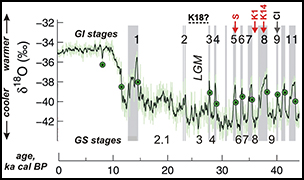Crossref Citations
This article has been cited by the following publications. This list is generated based on data provided by
Crossref.
Pettitt, Paul
2019.
Fast and slow science and the Palaeolithic dating game.
Antiquity,
Vol. 93,
Issue. 370,
p.
1076.
Higham, Thomas F.G.
2019.
Removing contaminants: a restatement of the value of isolating single compounds for AMS dating.
Antiquity,
Vol. 93,
Issue. 370,
p.
1072.
Witcher, Robert
2019.
From the wisdom of old age to a wider debate.
Antiquity,
Vol. 93,
Issue. 370,
p.
1079.
Uhm, Young Rang
Sun, Gwang-Min
Jin, Mi-Eun
Jwa, Yong-Joo
Seo, Jae Yeon
Choi, Hyunkyung
and
Kim, Chul Sung
2020.
Provenance Studies for Prehistoric Obsidian by Using Mössbauer Spectroscopy.
Journal of the Korean Physical Society,
Vol. 77,
Issue. 3,
p.
253.
Kuzmin, Yaroslav V
2020.
The Extinction of Late Pleistocene Large Mammals from North Eurasian Perspective – Review of Ross D.E. MacPhee (with illustrations by Peter Schouten). End of the Megafauna: The Fate of the World’s Hugest, Fiercest, and Strangest Animals. 2019. W. W. Norton & Co. ISBN: 978-0-39324-929-3; xii + 236 pages, with 83 illustrations and 1 table. List price $35 US (hardback). Photo courtesy of W. W. Norton & Co..
Radiocarbon,
Vol. 62,
Issue. 2,
p.
265.
Kuzmin, Yaroslav V.
Bondarev, Aleksei A.
Kosintsev, Pavel A.
and
Zazovskaya, Elya P.
2021.
The Paleolithic diet of Siberia and Eastern Europe: evidence based on stable isotopes (δ13C and δ15N) in hominin and animal bone collagen.
Archaeological and Anthropological Sciences,
Vol. 13,
Issue. 10,
Herrando-Pérez, Salvador
2021.
Bone need not remain an elephant in the room for radiocarbon dating.
Royal Society Open Science,
Vol. 8,
Issue. 1,
p.
201351.
Spindler, Luke
Comeskey, Daniel
Chabai, Victor
Uthmeier, Thorsten
Buckley, Michael
Devièse, Thibaut
and
Higham, Thomas
2021.
Dating the last Middle Palaeolithic of the Crimean Peninsula: New hydroxyproline AMS dates from the site of Kabazi II.
Journal of Human Evolution,
Vol. 156,
Issue. ,
p.
102996.
Dinnis, Rob
Bessudnov, Alexander A
Reynolds, Natasha
Khlopachev, Gennady A
Sablin, Mikhail
Sinitsyn, Andrei
Higham, Thomas
and
Douka, Katerina
2021.
THE TEMPO OF CULTURAL CHANGE IN THE KOSTENKI UPPER PALEOLITHIC: FURTHER INSIGHTS.
Radiocarbon,
Vol. 63,
Issue. 3,
p.
785.
Kuzmin, Yaroslav V
Boudin, Mathieu
Wojcieszak, Marine
Zazzo, Antoine
van der Sluis, Laura
Stulova, Darya I
Gavrilov, Konstantin N
Veselovskaya, Elizaveta V
and
Vasilyev, Sergey V
2022.
SUNGIR REVISITED: NEW DATA ON CHRONOLOGY AND STRATIGRAPHY OF THE KEY UPPER PALEOLITHIC SITE, CENTRAL RUSSIAN PLAIN.
Radiocarbon,
Vol. 64,
Issue. 5,
p.
949.
Kuzmin, Yaroslav V
2022.
The Late Quaternary Megafaunal Extinctions in Worldwide Perspective – Review of Anthony J. Stuart. Vanished Giants: The Lost World of the Ice Age. 2021. Chicago: University of Chicago Press. ISBN 978-0-22643-284-7. 310 pages, with 70 illustrations and 7 tables. List price $45 US (hardback)..
Radiocarbon,
Vol. 64,
Issue. 2,
p.
205.
Fiedel, Stuart J
2022.
INITIAL HUMAN COLONIZATION OF THE AMERICAS, REDUX.
Radiocarbon,
Vol. 64,
Issue. 4,
p.
845.
Kuzmin, Yaroslav V.
Slavinsky, Vyacheslav S.
Tsybankov, Aleksander A.
and
Keates, Susan G.
2022.
Denisovans, Neanderthals, and Early Modern Humans: A Review of the Pleistocene Hominin Fossils from the Altai Mountains (Southern Siberia).
Journal of Archaeological Research,
Vol. 30,
Issue. 3,
p.
321.





